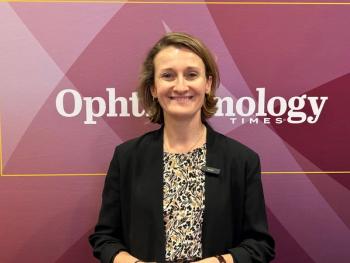
Novel scleral suture fixation technique stabilizes rotated toric IOL
Take-home message: A novel approach to scleral suture fixation of a rotated in-the-bag toric IOL stabilizes the implant at the desired axis and prevents rotation in both clockwise and counterclockwise directions.
Take-home message: A novel approach to scleral suture fixation of a rotated in-the-bag toric IOL stabilizes the implant at the desired axis and prevents rotation in both clockwise and counterclockwise directions.
By Cheryl Guttman Krader; Reviewed by Toby Chan, MD
Toronto, Ontario :: An innovative suture fixation approach for stabilizing a toric IOL rotating within the capsular bag is designed to take advantage of the implant’s double-loop haptic configuration in order to prevent any future implant rotation.
The surgery was performed by Toby Chan, MD, assistant clinical professor of ophthalmology (adjunct), McMaster University, Hamilton, Ontario, and Ike Ahmed, MD, assistant professor of ophthalmology, University of Toronto, Toronto, Ontario. Parnian Arjmand, MD, ophthalmology resident, University of Ottawa, Ottawa, Ontario, is the lead author of a published paper describing the technique [J Cataract Refract Surg. 2015;41(5):912-917].
The patient was a 64-year-old man who had uneventful cataract extraction and implantation of a 623T toric IOL (Rayner) with alignment to the desired axis of 100° in the capsular bag. At 1 week, the IOL had rotated counter-clockwise by 50° and was repositioned in the operating room back to the desired axis. However, the next month, the IOL had rotated again to 165° axis, resulting in uncorrected visual acuity (UCVA) of 20/200.
The patient chose to undergo scleral suture fixation performed via an ab externo approach with placement of two 9-0 polypropylene (Prolene) sutures through each of the double-loop haptics to create opposing vectors in order to stabilize the IOL against any rotation.
“In 2009, Borkenstein et al. described an approach to transscleral fixation of a toric IOL in an aphakic eye with no capsular bag support, and in 2013, McGrath and Lee reported on transscleral fixation of a supplementary sulcus-placed toric IOL with open-loop haptics,” Dr. Chan said.
“Their approaches involved placing one suture loop at the distal ends of the superior and inferior haptics and successfully stabilized the IOL in the desired axis,” Dr. Chan added. “However, while they theoretically prevented rotation in the counterclockwise direction, because both sutures are acting in the same rotational vector, it would not protect against clockwise rotation.
“Our technique is designed to prevent rotation in either direction in order to limit any chance that the patient would need further surgery,” he noted.
“After the second rotation, the patient was also offered spectacle correction or limbal relaxing incisions for his residual astigmatism, but he chose surgical repositioning of the IOL with understanding of the possible risks accompanying surgical intervention,” said Dr. Arjmand. “With 11 months of follow-up now available, the IOL remains at its desired axis, and the patient is happy with 20/20 best-corrected VA and 20/40 UCVA.”
Describing the technique
After marking the desired axis for IOL alignment, the anterior chamber and capsular bag were inflated with viscoelastic using the soft-shell technique described by Steven Arshinoff, MD. Then, the IOL was dialed into the proper position and a local peritomy was placed at the location of the planned scleral fixation. Iris hooks were placed through paracenteses to improve visualization of the haptics, minimal cautery was performed to stop subconjunctival bleeding, and a partial thickness scleral groove was created at the locations planned for suture exit.
Next, a 26-gauge hypodermic needle, which was to be used as a docking point, was inserted through the scleral groove and passed under the capsular bag-IOL complex through the middle of the superior double-loop haptic.
Then, the curved needle on a 9-0 polypropylene suture was placed through the docking needle, and the docking needle was pulled through the scleral groove to externalize the suture. Next, the 26-gauge needle was inserted again, but this time passed over and on top of the capsular bag-IOL complex into the sulcus.
The other end of the suture was externalized using the same docking maneuver.
“This technique creates a suture loop that hooks the entire haptic proximally and anchors the proximal end toward the sclera,” Dr. Chan said. “Then, the steps are repeated to place a second suture loop pulling from the opposite direction at the distal end of the same haptic.
“These two loops provide opposing rotational vectors that we reasoned would prevent the IOL from rotating in either clockwise or counterclockwise directions,” he explained.
The case was closed with the suture knots buried in the scleral groove, the conjunctiva closed with a 10-0 polyglactin 910 (Vicryl) suture, and all viscoelastic was removed from the anterior chamber.
Parnian Arjmand, MD
None of the authors have a financial interest in any of the products mentioned.
Newsletter
Don’t miss out—get Ophthalmology Times updates on the latest clinical advancements and expert interviews, straight to your inbox.



















































.png)


